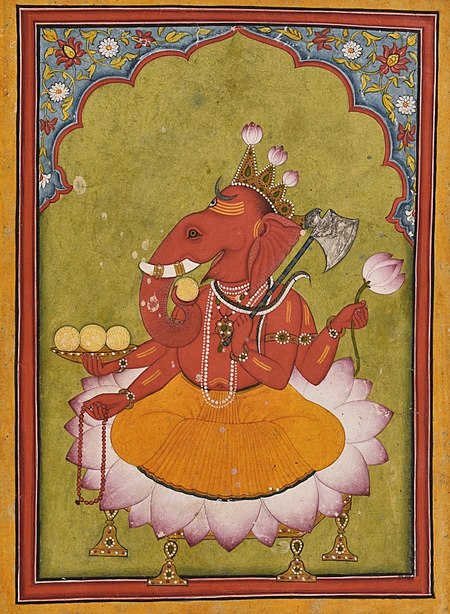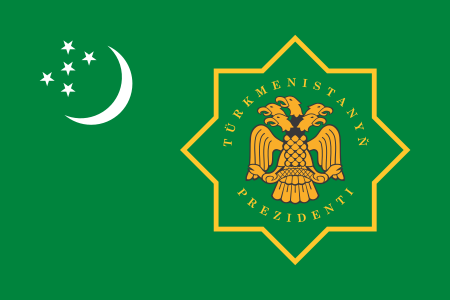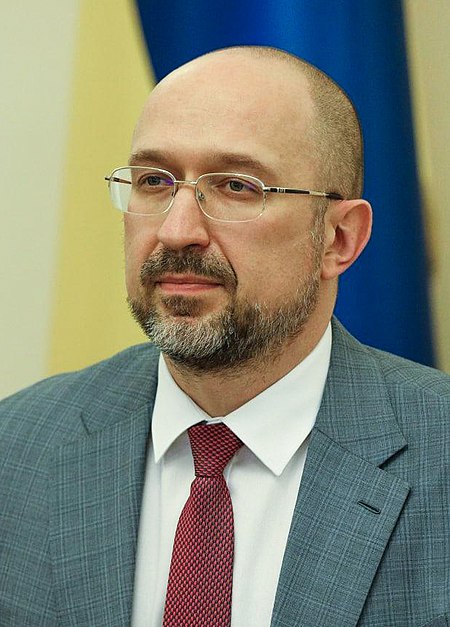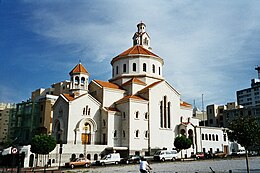Armenian Catholic Church
| ||||||||||||||||||||||||||||||||||||||||||||||||||||||||||||||||||||||||||||||||||||||||||||||||||||||||||||||||||||||||||||||||||||||||||||||||||||||||||
Read other articles:

Nazarudin Kiemas Anggota Dewan Perwakilan RakyatRepublik IndonesiaMasa jabatan1 Oktober 1999 – 26 Maret 2019Daerah pemilihanSumatera Selatan (Muara Enim)(1999—2004)Sumatera Selatan I(2004—19) Informasi pribadiLahir(1949-01-25)25 Januari 1949Kaliurang, Yogyakarta, IndonesiaMeninggal26 Maret 2019(2019-03-26) (umur 70)Tangerang Selatan, BantenPartai politikPartai Demokrasi Indonesia PerjuanganSuami/istriLyna SoertidewiHubunganTaufiq Kiemas (kakak) Megawati Soekarnoputri (ipar) P…

Artikel ini membahas mengenai bangunan, struktur, infrastruktur, atau kawasan terencana yang sedang dibangun atau akan segera selesai. Informasi di halaman ini bisa berubah setiap saat (tidak jarang perubahan yang besar) seiring dengan penyelesaiannya. Al Salam Tecom TowerInformasi umumLokasiDubai, Uni Emirat ArabPerkiraan rampung2008Data teknisJumlah lantai47Desain dan konstruksiArsitekDAR Consult As Salam Tecom Tower merupakan sebuah menara bertingkat 47 di Dubai Media City di Dubai, Uni Emira…

Hindu religious festival Ganesh ChaturthiLalbaugcha Raja, MumbaiOfficial nameChatur/Vinayaka Chaturthi/Vinayaka ChavithiAlso calledChavithi, Chouthi, GaneshotsavObserved byHindusTypeReligiousCelebrationsChanting of Vedic hymns and Hindu texts, prayers, processions, idol immersionEnds11 days after the startDateBhadra Shukla Chaturthi2023 date19 September[1]2024 date7 September[2]FrequencyAnnual Explanatory noteHindu festival dates The Hindu calendar is lunisolar but…

District in Bakool, SomaliaWajidDistrictCountry SomaliaRegionBakoolCapitalWajidTime zoneUTC+3 (EAT) Wajid District (Somali: Degmada Waajid) is a district in the southwestern Bakool region of Somalia. Its capital is Wajid. References External links Districts of Somalia Administrative map of Wajid District vte Administrative divisions of SomaliaAwdal Region Dilla District Baki District Borama District Lughaya District Zeila District Bakool Region Hudur District Rabdhure District Tiyeglow Dist…

Voce principale: Eccellenza 2004-2005. Eccellenza Molise2004-2005 Competizione Eccellenza Molise Sport Calcio Edizione 13ª Organizzatore FIGC - LNDComitato Regionale Molise Luogo Italia Cronologia della competizione 2003-2004 2005-2006 Manuale Il campionato italiano di calcio di Eccellenza regionale 2004-2005 è stato il quattordicesimo organizzato in Italia. Rappresenta il sesto livello del calcio italiano. Questi sono i gironi organizzati dal comitato regionale della regione Molise. Ind…

土库曼斯坦总统土库曼斯坦国徽土库曼斯坦总统旗現任谢尔达尔·别尔德穆哈梅多夫自2022年3月19日官邸阿什哈巴德总统府(Oguzkhan Presidential Palace)機關所在地阿什哈巴德任命者直接选举任期7年,可连选连任首任萨帕尔穆拉特·尼亚佐夫设立1991年10月27日 土库曼斯坦土库曼斯坦政府与政治 国家政府 土库曼斯坦宪法 国旗 国徽 国歌 立法機關(英语:National Council of Turkmenistan) 土�…
2020年夏季奥林匹克运动会波兰代表團波兰国旗IOC編碼POLNOC波蘭奧林匹克委員會網站olimpijski.pl(英文)(波兰文)2020年夏季奥林匹克运动会(東京)2021年7月23日至8月8日(受2019冠状病毒病疫情影响推迟,但仍保留原定名称)運動員206參賽項目24个大项旗手开幕式:帕维尔·科热尼奥夫斯基(游泳)和马娅·沃什乔夫斯卡(自行车)[1]闭幕式:卡罗利娜·纳亚(皮划艇)[2…

烏克蘭總理Прем'єр-міністр України烏克蘭國徽現任杰尼斯·什米加尔自2020年3月4日任命者烏克蘭總統任期總統任命首任維托爾德·福金设立1991年11月后继职位無网站www.kmu.gov.ua/control/en/(英文) 乌克兰 乌克兰政府与政治系列条目 宪法 政府 总统 弗拉基米尔·泽连斯基 總統辦公室 国家安全与国防事务委员会 总统代表(英语:Representatives of the President of Ukraine) 总理…

此条目序言章节没有充分总结全文内容要点。 (2019年3月21日)请考虑扩充序言,清晰概述条目所有重點。请在条目的讨论页讨论此问题。 哈萨克斯坦總統哈薩克總統旗現任Қасым-Жомарт Кемелұлы Тоқаев卡瑟姆若马尔特·托卡耶夫自2019年3月20日在任任期7年首任努尔苏丹·纳扎尔巴耶夫设立1990年4月24日(哈薩克蘇維埃社會主義共和國總統) 哈萨克斯坦 哈萨克斯坦政府與�…

Artikel ini sebatang kara, artinya tidak ada artikel lain yang memiliki pranala balik ke halaman ini.Bantulah menambah pranala ke artikel ini dari artikel yang berhubungan atau coba peralatan pencari pranala.Tag ini diberikan pada Januari 2023. SMA Negeri 14 Ambon merupakan salah satu sekolah menengah atas negeri yang terletak di Negeri Passo Jln. Wolter Monginsidi, Lorong Pertanian lembah Argo. Kota Ambon- Provinsi Maluku, Indonesia. SMA Negeri 14 AmbonInformasiDidirikan28 Oktober 2011Akreditas…

本條目存在以下問題,請協助改善本條目或在討論頁針對議題發表看法。 此條目需要編修,以確保文法、用詞、语气、格式、標點等使用恰当。 (2013年8月6日)請按照校對指引,幫助编辑這個條目。(幫助、討論) 此條目剧情、虛構用語或人物介紹过长过细,需清理无关故事主轴的细节、用語和角色介紹。 (2020年10月6日)劇情、用語和人物介紹都只是用於了解故事主軸,輔助讀�…

هذه مقالة غير مراجعة. ينبغي أن يزال هذا القالب بعد أن يراجعها محرر؛ إذا لزم الأمر فيجب أن توسم المقالة بقوالب الصيانة المناسبة. يمكن أيضاً تقديم طلب لمراجعة المقالة في الصفحة المخصصة لذلك. (يناير 2022) مفتش أسلحة تابع للأمم المتحدة في العراق عام 2002. بدأ صدام حسين (1937-2006) برنامجًا …

Wakil Bupati TapinPetahanaLowongsejak 20 September 2023Masa jabatan5 tahunDibentuk2003Pejabat pertamaDrs. Achmad Fauzi, M.AP.Situs webweb.tapinkab.go.id Berikut ini adalah daftar Wakil Bupati Tapin dari masa ke masa. No Wakil Bupati Mulai Jabatan Akhir Jabatan Prd. Ket. Bupati 1 Drs.Achmad FauziM.AP. 2003 2008 1 Drs. H.Idis Nurdin HalidiM.AP. 19 Februari 2008 19 Februari 2013 2 3 Ir. H.Sufian NoorM.P. 19 Februari 2013 15 Februari 2018 3 [Ket. 1][1] Drs. H. M.Ar…

Brisbane Roar YouthNama lengkapBrisbane Roar FC YouthJulukanRoar, BRFC NYLBerdiri2008StadionGoodwin ParkPerry ParkPemilikBakrie GroupChairmanDali TahirManajerJeff HopkinsLigaNational Youth League2013–147th Kostum kandang Kostum tandang Musim ini Brisbane Roar FC Youth adalah tim kedua dari Brisbane Roar. Tim ini bermain di Liga Remaja Nasional, dengan stadion Goodwin Park, dan juga di Liga Utama Nasional Queensland, dengan stadion Perry Park. Sejarah Tim ini didirikan pada tahun 2008, sebagai …

Legality, use and culture of cannabis in the U.S. state of Alaska Indoor cultivation facility in Alaska Cannabis in Alaska is legal for recreational use since 2014. It was first legalized by the court ruling Ravin v. State in 1975, but later recriminalized by Measure 2 in 1990. Ballot measures in 2000 and 2004 attempted (but failed) to legalize recreational use, until finally Measure 2 in 2014 passed with 53.2% of the vote. Medical use was legalized by way of Measure 8 in 1998.[1] Histor…

This article needs additional citations for verification. Please help improve this article by adding citations to reliable sources. Unsourced material may be challenged and removed.Find sources: Grand Canyon: The Hidden Secrets – news · newspapers · books · scholar · JSTOR (July 2016) (Learn how and when to remove this message) 1984 American filmGrand Canyon: The Hidden SecretsA screenshot of the title sequenceDirected byKieth MerrillWritten byKieth Merri…

Area code for northern Minnesota A map of Minnesota area codes Area code 218 is a telephone area code in the North American Numbering Plan (NANP) for the northern part of the U.S. state of Minnesota. It is assigned to the largest of Minnesota's original two numbering plan areas (NPAs), although its geographical boundaries have been modified since inception. It comprises roughly the northern half of the state, and includes the cities of Duluth, Hibbing, Brainerd, Bemidji, Fergus Falls, and Moorhe…

Artikel ini sebatang kara, artinya tidak ada artikel lain yang memiliki pranala balik ke halaman ini.Bantulah menambah pranala ke artikel ini dari artikel yang berhubungan atau coba peralatan pencari pranala.Tag ini diberikan pada Oktober 2020. Untuk orang lain dengan nama yang sama, lihat John Pepper (disambiguasi). John PepperPepper pada sekitar tahun 1919LahirJózsef Schwarz(1886-11-08)8 November 1886Budapest, Austria-HungariaMenghilang29 Juli 1937 (pada umur 50 tahun)Moskwa, Uni SovietM…

العلاقات اليمنية النيبالية اليمن نيبال اليمن نيبال تعديل مصدري - تعديل العلاقات اليمنية النيبالية هي العلاقات الثنائية التي تجمع بين اليمن ونيبال.[1][2][3][4][5] مقارنة بين البلدين هذه مقارنة عامة ومرجعية للدولتين: وجه المقارنة اليمن نيبال �…

Torneo di Wimbledon 1990Singolare femminileSport Tennis Vincitrice Martina Navrátilová Finalista Zina Garrison Punteggio6–4, 6–1 Tornei Singolare uomini donne ragazzi ragazze Doppio uomini donne misto 1989 1991 Voce principale: Torneo di Wimbledon 1990. Steffi Graf era la detentrice del titolo ma è stata sconfitta in semifinale da Zina Garrison, nell'incontro per il titolo ha avuto la meglio Martina Navrátilová sulla connazionale Garrison con il punteggio di 6–4, 6–1. È stat…



















